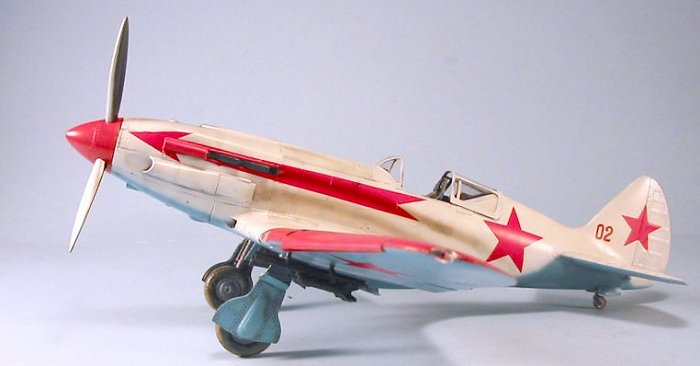
|
KIT: |
Trumpeter 1/32 Mig-3 |
|
KIT # |
? |
|
PRICE: |
$49.95 MSRP |
|
DECALS: |
two options |
|
REVIEWER: |
Tom Cleaver |
|
NOTES: |

|
HISTORY |
The Soviet Union had an extremely-bureaucratic method of creating new airplanes up until 1939. A requirement for a new design would be passed to either the TsAGI (the Central Aero and Hydrodynamic Institute) whose department of Experimental Aircraft Design was headed by Andrei Tupolev, or to the TsKB (Central Design Bureau), whose experimental aircraft section was supervised by Nikolai Polikarpov. This system had resulted in the creation of two fighters - the I-15 and I-16 - which were at least the equal of western designs if not in advance of them at the time the aircraft first appeared, and the SB-2 bomber which was in advance of any similar type when it became operational. However, the People's Commissariats for the Aviation Industry and for Defense were forced to conclude by late 1938 that V-VS fighters had fallen behind world standards - as revealed in the Spanish Civil War - and that no successors were in prospect.
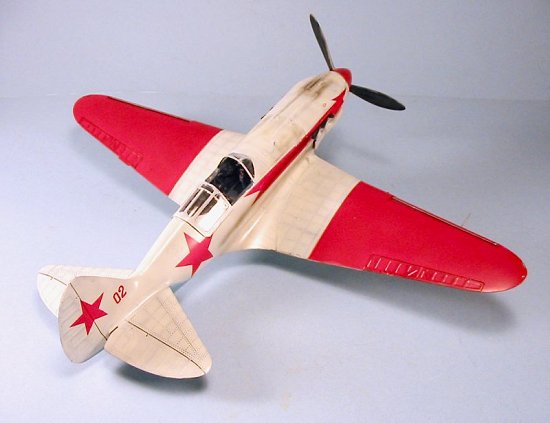 Even
communists can resort to pragmatism, and the result of this situation was
the decision that the more talented design brigade leaders within these
two organizations would now be encouraged to form their own experimental
design bureaus and compete with one another in fulfilling official
specifications. It would soon be seen that this decision was made just
in time to save the Soviet Union in the in the war everyone but Stalin
could see coming in 1939. The result of this competition would see the
development of the two major Soviet fighter designs of the war, those
created by Alexsandr Yakovlev and those from the design table of Semyon
Lavochkin. There would also be a third design that would result from
this change of policy.
Even
communists can resort to pragmatism, and the result of this situation was
the decision that the more talented design brigade leaders within these
two organizations would now be encouraged to form their own experimental
design bureaus and compete with one another in fulfilling official
specifications. It would soon be seen that this decision was made just
in time to save the Soviet Union in the in the war everyone but Stalin
could see coming in 1939. The result of this competition would see the
development of the two major Soviet fighter designs of the war, those
created by Alexsandr Yakovlev and those from the design table of Semyon
Lavochkin. There would also be a third design that would result from
this change of policy.
Artem Mikoyan, highly-creative but relatively inexperienced, joined with an older and appreciably more experienced engineer, Mikhail Gurevich, to form a design bureau. The fact that Mikoyan was the younger brother of a high-ranking and powerful Politburo member, and therefore extremely likely to have his views heard, probably never entered Gurevich's mind when he decided to join forces to form the what became the MiG bureau.
In early 1939, the V-VS issued a requirement for a single-seat interceptor fighter offering maximum performance at altitudes above 6,000 m (18,290 ft), to be powered by the supercharged AM-35A engine newly developed by Alexsandr Mikulin at the TsIAM, the Central Institute of Aviation Motor Construction. When Mikoyan and Gurevich looked into the various requirements they might possibly meet with a new design, this one struck Mikoyan particularly, inasmuch as it called for an airplane optimized for speed over all other capabilities, as compared with the requirements for a medium-altitude fighter which required compromise, since maneuverability was regarded as important as other performance aspects.
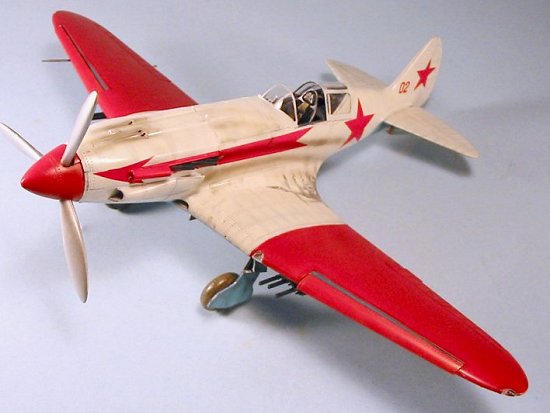 The result was
the smallest practical airframe capable of accommodating the AM-35A
engine, pilot and armament, submitted in October 1939 as the I-200. It
was immediately accepted, and such was the urgency attached to
re-equipment of the V-VS with modern aircraft that instructions were
issued to factory "Zavod I" to commence tooling for production prior to
the flight of the prototype. The first of 100 I-200s ordered flew on
April 5, 1940, just five months from the commencement of construction.
On May 4, 1940, a level speed of 403 mph (648.5 km/h) was obtained at
6,900 m (22,640 ft), making the airplane the fastest in the Soviet Union.
The result was
the smallest practical airframe capable of accommodating the AM-35A
engine, pilot and armament, submitted in October 1939 as the I-200. It
was immediately accepted, and such was the urgency attached to
re-equipment of the V-VS with modern aircraft that instructions were
issued to factory "Zavod I" to commence tooling for production prior to
the flight of the prototype. The first of 100 I-200s ordered flew on
April 5, 1940, just five months from the commencement of construction.
On May 4, 1940, a level speed of 403 mph (648.5 km/h) was obtained at
6,900 m (22,640 ft), making the airplane the fastest in the Soviet Union.
From the outset of flight test, it was obvious the I-200 was - at best! - no novice's aircraft. Smaller than the Spitfire, but with a heavier wing loading, the airplane had poor longitudinal stability and its controls were heavy; it had a marked proclivity to spin at the least provocation. Takeoffs and landings required a high degree of competence from the pilot. By the summer of 1940, it was obvious only a major redesign could completely eradicate the less desirable features; however, the airplane was in production, and the need was such the line could not be shut down for such an undertaking. (Both the I-22, which would become the LaGG-3 and the I-26, the future Yak-1, were experiencing similar problems at the time.) Aleksei Shakurin, recently appointed Commissar for Aircraft Production by Stalin, took the position that the most important difficulties could be ironed out without major redesign and disruption of the assembly line.
The I-200 became the MiG-1 in series production, and retained all of the bad qualities of the prototypes; these in fact worsened with the additional weight of such items as weapons, ammunition and protective armor. Speed at maximum altitude dropped to 390 mph (628 km/h), and a bit over 320 mph at 1000 m (3,500 ft). At the time, the extreme speed loss at low and medium altitude was not considered a problem, since it was assumed the airplane would not be operating in such an environment in combat. The airplane introduced the V-VS to the phenomenon of the high-speed stall/spin, which did little to endear it to its pilots, who became cautious in how they threw it around the sky in simulated combat.
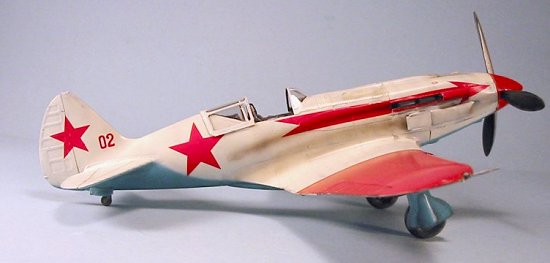 As predicted
by Shakurin, a number of small design changes were made, most notably
modification of the air intakes, forward extension of the ventral
radiator bath, and several degrees of additional dihedral to the outer
wings. These marginally improved performance and decidedly improved
stability. These resulted in a designation change to MiG-3. Still no
novice's aircraft and demanding a highly-skilled pilot in an air force
which had many of the former and few of the latter, the MiG-3 was
nonetheless a major improvement over its predecessor.
As predicted
by Shakurin, a number of small design changes were made, most notably
modification of the air intakes, forward extension of the ventral
radiator bath, and several degrees of additional dihedral to the outer
wings. These marginally improved performance and decidedly improved
stability. These resulted in a designation change to MiG-3. Still no
novice's aircraft and demanding a highly-skilled pilot in an air force
which had many of the former and few of the latter, the MiG-3 was
nonetheless a major improvement over its predecessor.
MiG-3s began entering service in the spring of 1941. The units operating them had little time to familiarize themselves before they were thrown into the caldron of "Operation Barbarossa," the German invasion of the Soviet Union which began June 22, 1941. Alexsandr Pokryshkin gained his first victory over a Bf-109 with a MiG-3 on the first day of the war - after scoring his very first victory with an “own goal” over a then-secret Su-2 which he failed to recognize until he saw the red stars on completion of his firing pass - but Luftwaffe fighter pilots reported that in general MiG-3 units seemed particularly lacking in aggressiveness. This was recognition on the part of the pilots that the airplane was at a distinct disadvantage against the Bf-109F at altitudes below 18,000 ft., where the majority of combat was taking place. MiG-3 pilots tried to avoid combat with German fighters and go after the bombers and reconnaissance aircraft the MiG had been designed to kill. As Pokryshkin put it, if a pilot stayed in the vertical plane, utilizing the plane’s weight to dive quickly on a target and the power of the AM-35A to zoom back to altitude, victories could be scored; unfortunately, few of his fellow pilots had his skill.
With the MiG-3 available in substantially greater numbers than the "frontal fighters" - the LaGG-3 and Yak-1 - and despite its manifest unsuitability for any mission other than high-altitude interception of bombers, the first six months of its war was spent fulfilling missions it was never designed for. Hanging RS-82 rockets under the wings improved ground attack capability at the expense of what little maneuverability the fighter had at the outset.
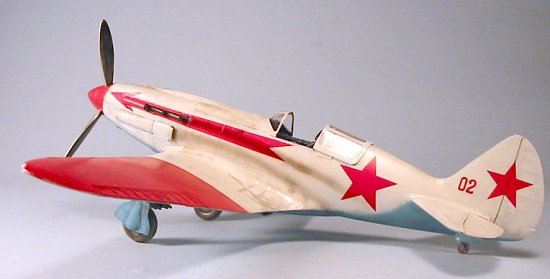 After the
Soviet Union turned back the German offensive at the gates of Moscow in
December 1941, and with the increasing availability of Yak-1s and
LaGG-3s, the MiG-3 was gradually withdrawn from frontal fighter units and
assigned to the IA-PVO air defense units. With this change in
assignment, the 12 IAP in the western sector of the Moscow PVO so
distinguished itself in combat that it was awarded the coveted "Guards
Regiment" title in March 1942.
After the
Soviet Union turned back the German offensive at the gates of Moscow in
December 1941, and with the increasing availability of Yak-1s and
LaGG-3s, the MiG-3 was gradually withdrawn from frontal fighter units and
assigned to the IA-PVO air defense units. With this change in
assignment, the 12 IAP in the western sector of the Moscow PVO so
distinguished itself in combat that it was awarded the coveted "Guards
Regiment" title in March 1942.
With virtually all combat on the eastern front taking place at low to medium altitudes, a high altitude interceptor was a luxury the Soviet Union quickly discovered it could not afford. The MiG-3 was taken out of production in November, 1941, with a total of 3,322 aircraft delivered since the previous March. It remained in service until the end of the war, assigned to rear-area air defense. Mikoyan and Gurevich, who were "unemployed" as a result, became involved in the brand-new development of turbojet power; their fame would come later.
|
THE KIT |
Trumpeter: What A Difference A Year Makes!
The MiG-3 is
Trumpeter’s latest release of a World War II fighter in 1/32 or 1/24
scale. What a difference a year makes!! Their 1/24 P-51 Mustang and
Zero, and 1/32 Wildcat - all released during the first quarter of 2003 -
left one gasping at the major outline faults in the kits, and wondering
if any research had gone into the production, that such mistakes could be
made. Modelers around the world argued as to whether Trumpeter should be
the target of a pre-emptive nuclear strike, or whether those who
complained about the kits should be lynched from the nearest lamp post
and left to dangle for daring to question a company that deigned to
release something that “looks like a (fill in this space) to me!” The
complaints about the Wildcat were so vociferous - with the proprietor of
a major scale modeling website demonstrating the inaccuracy of the model
in all areas by publicly comparing it with drawings - that the company
was forced (in the face of order cancellations by major distributors) to
pull back the kit and rework it. Mention of the faults of the Mustang
and Zero can still bring about
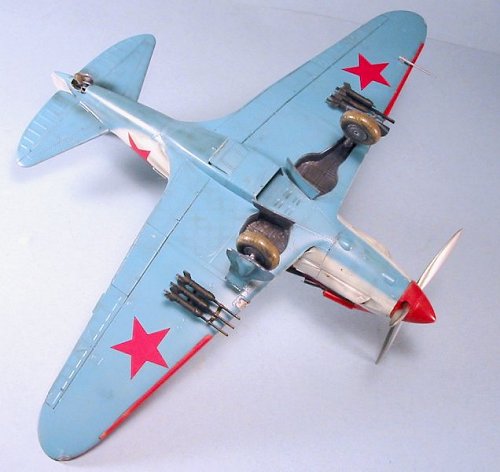 World War III among the two camps. The
Spitfire V was a marginal improvement, though it still had major shape
problems. Modelers around the world waited with bated breath for the
thudding release of the Bf-109G-6, and the sigh of relief that was heard
when it turned out to be no worse than any other kit could be heard
around the planet by any modeler who stepped into their back yard.
World War III among the two camps. The
Spitfire V was a marginal improvement, though it still had major shape
problems. Modelers around the world waited with bated breath for the
thudding release of the Bf-109G-6, and the sigh of relief that was heard
when it turned out to be no worse than any other kit could be heard
around the planet by any modeler who stepped into their back yard.
I have certainly had my own share of troubles with Trumpeter kits, from the 1/32 MiG-15 I built for Ed Maloney that left the air over the workbench a deep shade of royal purple, to the 1/48 MiG-15 that was not only thrown against the wall but stomped into its component atoms under a pair of cowboy boots. The kits from the outset have looked good still on the sprues and lying in the box. Cutting the parts off the sprues and attempting to fit them together was something else entirely.
Thus, it is really nice to say that this new MiG-3 was perhaps the most enjoyable modeling experience I have had in 2003. Looking at it in the box - preparing to do a “first look review” - the individual parts looked so nice they inevitably led to the question “I wonder how they fit?” Within a day, I found they all fit so well that the model was ready for the paint shop the second day out of the box. This was not due to my being “Tom The Speed Demon,” but rather to the quality of the kit design, which is competitive with anything released in 1/48 scale by Tamiya in terms of “buildability.” Not only that, but the finished product certainly looks like an accurate representation of a MiG-3. I admit not having enough knowledge of the type to be able to tell if it accurately represents a “short nose” early production version or a “long nose” later version, but it certainly looks better than the 1/48 ICM kit - which until now has been my candidate for best kit of the type.
Those who know me will understand when I say I never waste time on crap kits or crap movies - crap is crap and generally unsalvageable. My heavy artillery of criticism is reserved for those that “coulda been a contendah.” My ire is aimed at the project where those doing it had the intelligence, the skill, and the ability to “get it right” and didn’t. I am always happy to report when an offender mends their ways, and that is what this review is about.
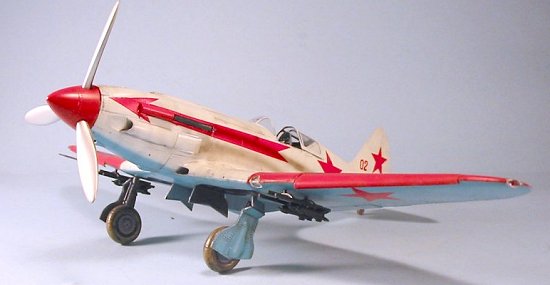 The kit comes
in the now-typical Big Strong Trumpeter Box, with box art that is
adequate but nothing to scare any competent aviation artist doing a kit
box for a competitor.
The kit comes
in the now-typical Big Strong Trumpeter Box, with box art that is
adequate but nothing to scare any competent aviation artist doing a kit
box for a competitor.
Fortunately, the 134 pieces that make up this kit do not include a model of the AM-35A engine. The modeler will be left to build this one “closed up,” which preserves the racer-like lines of the original airplane. The parts are crisply molded, with what I would consider “heavy” surface detail that includes individually-engraved holes representing flush rivets. In reality, a flush-riveted airplane is just that: nice and smooth, and you don’t notice the rivets unless you get up really close. However, for purposes of a model, this surface detail is not a killer, and it actually looks pretty good under a coat of paint. The “fabric effect” on the control surfaces is also worthy of note. Again, it’s a bit heavy, meant to represent rib tape over flat fabric - but that by itself is a vast improvement over the usual “hills and valleys” manufacturers have traditionally used to represent fabric cover - and again, the final effect is not bad under a coat of paint. Those modelers who care about fidelity to the original could sand down the raised rib tape detail in a matter of moments and get just the effect they wanted.
Cockpit detail is a bit sparse, but then the original cockpit was sparse. Those “large scale modelers” who want to add a bit of scratchbuilt detail in the form of throttle levers, etc., will be rewarded with an even-nicer cockpit, but - to me at least - the cockpit is good enough out of the box with perhaps the use of a Cutting Edge resin posable seatbelt set, that all but the confirmed “resin head” will be able to save the $20 for an aftermarket cockpit, to invest in another kit.
|
CONSTRUCTION |
Amazingly enough, the instructions here are very good, and if the modeler starts at step one and follows to step last, they’ll be rewarded with an excellent model.
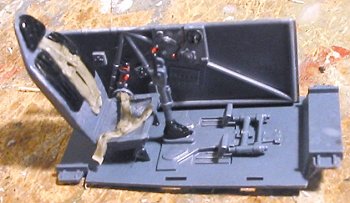 There are two
areas where my build differed from the instructions: Number One, I didn’t
want to fiddle with the metal rod/photoetch attachment system to pose the
control surfaces “dynamically.” I found that it was very easy to glue
the ailerons and flaps to the wing, the elevators to the horizontal
stabilizer, and the rudder to the fusel
There are two
areas where my build differed from the instructions: Number One, I didn’t
want to fiddle with the metal rod/photoetch attachment system to pose the
control surfaces “dynamically.” I found that it was very easy to glue
the ailerons and flaps to the wing, the elevators to the horizontal
stabilizer, and the rudder to the fusel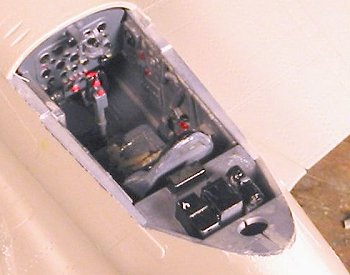 age. I glued the upper half of
the ailerons to the upper wing half, then the rest of the aileron was
glued on and the upper and lower wing parts glued together. The flaps
fit with no problem. I glued each rudder half to its appropriate
fuselage half before assembling the fuselage, while the elevators and
horizontal stabilizers were assembled separately and glued together. As
to the little slits in the control surfaces for the photoetch parts, I
filled those with white glue.
age. I glued the upper half of
the ailerons to the upper wing half, then the rest of the aileron was
glued on and the upper and lower wing parts glued together. The flaps
fit with no problem. I glued each rudder half to its appropriate
fuselage half before assembling the fuselage, while the elevators and
horizontal stabilizers were assembled separately and glued together. As
to the little slits in the control surfaces for the photoetch parts, I
filled those with white glue.
Number Two was the color callouts in the instructions. I went over
to the V-VS modeling page and looked over the information they have -
which I think is the most complete anywhere - on the MiG-3. It
appears that the interior of
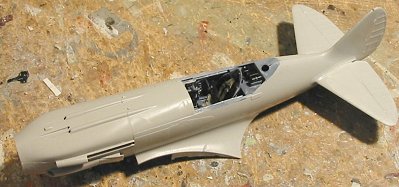 the cockpit and the
landing gear and interior of the gear wells and gear doors could have
been painted in one of three ways: a light green similar to British or
Italian Interior Green, the underside blue color, or a blue-grey color.
I chose to paint the cockpit and gear with Gunze-Sangyo “Blue Grey.”
This was mostly for artistic effect since I was going to do a
winter-camouflage airplane with the red outer wings, and wanted to
maximize different colors.
the cockpit and the
landing gear and interior of the gear wells and gear doors could have
been painted in one of three ways: a light green similar to British or
Italian Interior Green, the underside blue color, or a blue-grey color.
I chose to paint the cockpit and gear with Gunze-Sangyo “Blue Grey.”
This was mostly for artistic effect since I was going to do a
winter-camouflage airplane with the red outer wings, and wanted to
maximize different colors.
Past that, I followed the kit instru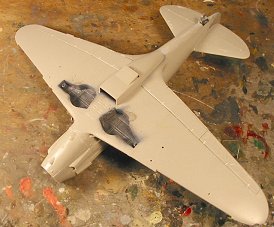 ctions,
and encountered absolutely no problems in assembly. Well...almost - I
would suggest you not glue the oil cooler intakes to the wing until after
you attach the wing subassembly to the fuselage; if you do it this way,
you can fiddle with the attachment and perhaps not end up with the small
gap on the underside of the fuselage between these parts and the lower
part of the cowling (not that filling the “gap” with white glue was any
major problem).
ctions,
and encountered absolutely no problems in assembly. Well...almost - I
would suggest you not glue the oil cooler intakes to the wing until after
you attach the wing subassembly to the fuselage; if you do it this way,
you can fiddle with the attachment and perhaps not end up with the small
gap on the underside of the fuselage between these parts and the lower
part of the cowling (not that filling the “gap” with white glue was any
major problem).
I assembled that dinky tail wheel to the model at the proper point in assembly because you cannot do otherwise, but let me assure you, you will need to be careful once it’s in there that you don’t knock it about or knock it off - getting it back in there afterwards would definitely turn the air over the workbench at least a moderate shade of purple.
At the end of about 6-7 hours’ work, the model was ready to go to the paint shop the next morning.
|
COLORS AND MARKINGS |
My first
thought was to do the model in the green-blue camouflage of Aleksandr
Pokryshkin’s airplane, “White Five” (one of the two marking
possibilities). I definitely did not want to do a model this big in
overall white upper surfaces- the other
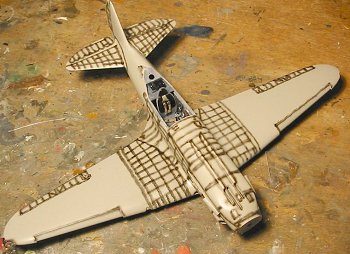 kit-supplied alternative.
However, the airplanes of the 12 IAP of the Western Moscow PVO were the
most-photographed MiG-3s of the war, and the winter scheme is a nice
one. I finally decided after looking at models in the gallery over at
the V-VS modeling site, and going through the Decal Dungeon, that I would
do “02" of this unit, an airplane with red outer wings. (Of course,
right after I painted the model, a researcher I know told me it was very
likely the wings were green - outer wings from an uncamouflaged MiG-3
used to repair this airplane. Perhaps so - serious V-VS modelers might
want to consider obtaining more information on this. But this is a nice
“air show paint job,” and the model already looks good as you read this,
sitting in its own glass case out at Planes of Fame.)
kit-supplied alternative.
However, the airplanes of the 12 IAP of the Western Moscow PVO were the
most-photographed MiG-3s of the war, and the winter scheme is a nice
one. I finally decided after looking at models in the gallery over at
the V-VS modeling site, and going through the Decal Dungeon, that I would
do “02" of this unit, an airplane with red outer wings. (Of course,
right after I painted the model, a researcher I know told me it was very
likely the wings were green - outer wings from an uncamouflaged MiG-3
used to repair this airplane. Perhaps so - serious V-VS modelers might
want to consider obtaining more information on this. But this is a nice
“air show paint job,” and the model already looks good as you read this,
sitting in its own glass case out at Planes of Fame.)
I first preshaded the model with black over panel lines and also over the rivet
lines on the metal parts of the airframe. I then started with a mixture
of Tamiya X-14 Sky Blue and XF-23 Light Blue to get a lower color that
approximated the color in the profiles over at the V-VS site. I did the
winter camouflage with Gunze-Sangyo H-316 White FS17875, which is an
“of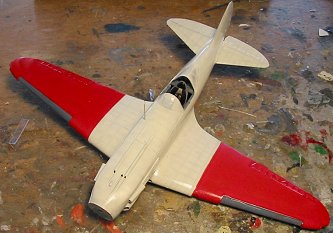 f-white” used in USN gull-grey-over-white schemes, and not so bright
as a regular white. Thinned, this created a “ragged effect” over the
pre-shaded areas, making the metal sections of the airframe appear darker
since there was so much pre-shading beneath it, while not being really
careful about an “even coat” over the rest left the final result looking
like white paint over an underlying color, which is what should be. When
that was dry, I masked off the white areas of the wings (be sure to mask
all the way to the fuselage and up a ways to protect from red overspray
on white, a particularly-difficult mistake to correct - I speak from
experience), and shot the outer wings with Gunze-Sangyo “Shine Red” a
bright scarlet red. I also painted the prop spinner this color. When
all was dry, the model got an overall coat of Future.
f-white” used in USN gull-grey-over-white schemes, and not so bright
as a regular white. Thinned, this created a “ragged effect” over the
pre-shaded areas, making the metal sections of the airframe appear darker
since there was so much pre-shading beneath it, while not being really
careful about an “even coat” over the rest left the final result looking
like white paint over an underlying color, which is what should be. When
that was dry, I masked off the white areas of the wings (be sure to mask
all the way to the fuselage and up a ways to protect from red overspray
on white, a particularly-difficult mistake to correct - I speak from
experience), and shot the outer wings with Gunze-Sangyo “Shine Red” a
bright scarlet red. I also painted the prop spinner this color. When
all was dry, the model got an overall coat of Future.
Decals:
The kit decals are nothing to write home about, but they work. I had to use some “Shine Red’ to fill in the area around the exhausts on the arrow, but it was not a problem. I applied the red stars and the “02" from a decal sheet found in the Decal Dungeon. When they were dry, I gave the model another coat of Future.
|
FINAL ASSEMBLY |
I did the exhaust stains with Tamiya Smoke, working from a photograph of these 23 IAP airplanes. You will note some staining from under the cowling panels that flows back in the slipstream; the Am-35A was an oil burner.
I then attached the main gear, the prop and spinner, and the sliding part of the canopy. With a coat of Dullcote mixed with Glosscote, I got a “satin” finish overall, which I think accords with the heavy coat of polish Russian airplanes received.
|
CONCLUSIONS |
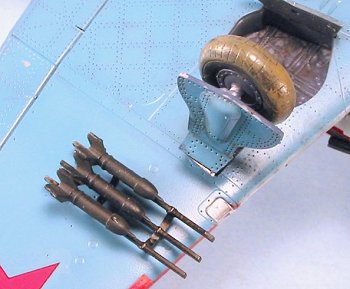 It’s always
nice when something lives up to your hopes, rather than down to your
expectations. This Trumpeter kit is - as I said earlier - as nice as
anything you will get from Tamiya or Hasegawa. They have opted for the
“simple model” idea Hasegawa is following with their 1/32 Bf-109s and
Fw-190s, rather than the “everything including the kitchen sink” approach
of Tamiya with their Zero. Personally, I like that, because it allows a
scratchbuilder to apply their skill in some areas, and it lets the
aftermarket folks pay the rent with the income they get from the resin
heads (BTW - I frequently am a “resin head”, so do not take that
as a put-down.) At a retail price of around $50, this kit is good value
for the money and results in a very nice model.
It’s always
nice when something lives up to your hopes, rather than down to your
expectations. This Trumpeter kit is - as I said earlier - as nice as
anything you will get from Tamiya or Hasegawa. They have opted for the
“simple model” idea Hasegawa is following with their 1/32 Bf-109s and
Fw-190s, rather than the “everything including the kitchen sink” approach
of Tamiya with their Zero. Personally, I like that, because it allows a
scratchbuilder to apply their skill in some areas, and it lets the
aftermarket folks pay the rent with the income they get from the resin
heads (BTW - I frequently am a “resin head”, so do not take that
as a put-down.) At a retail price of around $50, this kit is good value
for the money and results in a very nice model.
Looking at the new P-40B, I think Trumpeter listened to the complainers and decided to do their homework in the design stage. So much for “taking what they hand you.” This model proves that the “squeaky wheel” does indeed get the grease. I am now looking forward to the next Trumpeter kit I build, the same way I look forward to a new Tamiya or Hasegawa kit.
December 2003
Highly recommended.
Thanks to Stevens International for the review kit.
|
REFERENCES |
There are two references that any Mig-3 fan needs to have. One is the new Red Star book on the history of MiG piston engined fighters. It goes into great detail on this particular plane since it was basically the only successful piston powered plane they did. The second is on the colors of VVS Fighters during WWII by Classic Publications. It gives you everything you need to know about the proper color combinations used by VVS fighters during the war. It also has a rather in-depth history section of each plane type so if you can't justify both books, get this one. White Ensign's new VVS color line has been formulated from research done by this book
If you would like your product reviewed fairly and quickly by a site that has over 200,000 visitors a month, please contact me or see other details in the Note to Contributors.